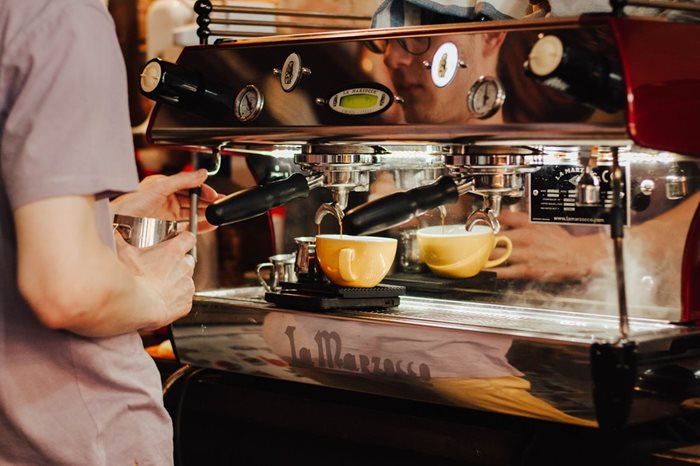Concluding our series exploring environmental sustainability across coffee's epic supply chain, we turn the spotlight on carbon generation in coffee shops. Catch up on parts one and two here
 An espresso machine can have annual carbon emissions equivalent to a flight from London to Costa Rica | Photo credit: Marta Dzedyshko
An espresso machine can have annual carbon emissions equivalent to a flight from London to Costa Rica | Photo credit: Marta Dzedyshko
Cutting carbon in coffee shops
The final stop in coffee’s epic global voyage through the value chain is often the coffee shop. Here, coffee’s carbon footprint becomes diffused among many operational elements, such as espresso machines, dishwashers, and lighting, all of which contribute a peripheral and hidden carbon impact.
“These processes are very energy intensive and that’s why they are the greatest components of a cup of coffee’s carbon footprint,” says Tim Ridley, Founder of
United Baristas, a UK-based organisation providing training, expertise and access to resources for coffee shops and hospitality businesses.
Ridley cites four academic studies (
Salinas 2008,
Humbert 2009,
Chayer 2015 and
Killian 2013) that attribute preparation in hospitality venues as accounting for around 50% of coffee’s total carbon footprint.
An infrequently used espresso machine using 5,000 kWh each year consumes more electricity than the average UK home. A moderately busy espresso machine using 10,000 kWh per annum is responsible for carbon emissions of 2.92 tons – more than a return flight from London to Costa Rica.
“Cafés can get the carbon footprint of a standard flat white down to around 50g by using an energy-efficient espresso machine"
However, there are small steps cafés can take to instigate bigger-picture changes to their carbon footprint. Smaller espresso machines with fewer group heads consume less energy, meaning operators should choose a model suited to their volumes, advises Ridley. Simply turning off or programming machines to stand by during downtime is another effective method – as is more efficient group head purging, which can be reliably completed with a two-second blast of hot water.
The addition of milk to coffee is also another huge factor behind a coffee beverage’s overall carbon footprint, doubling or even tripling its impact. Producing one litre of cow’s milk results in 3kg carbon footprint. However, oat and almond alternatives have just 0.9kg and 0.7kg footprints respectively according to a 2018
study by Poore and Nemecek.
Switching from takeaway to porcelain cups reduces single-use waste and lowers the carbon cost of each coffee from around 11 grams to nine once dishwashing is factored in. The numbers may not seem like a hill of beans, but maintained over a scaled business annually and the effects become tangible.
“Cafés can get the carbon footprint of a standard flat white down to around 50g by using an energy-efficient espresso machine and choosing a dairy alternative, such as oat milk. These are changes consumers can make but the industry must play its part in reducing energy consumption as well,” says Ridley.
 Dairy milk can double or even triple the carbon footprint of a cup of coffee | Photo credit: Pars Sahin
Dairy milk can double or even triple the carbon footprint of a cup of coffee | Photo credit: Pars Sahin
There is no magic bullet to reducing carbon emissions in coffee shops. However, those operators taking a holistic approach to consistently reducing emissions across every facet of their business stand to make meaningful reductions. The business case for reducing energy consumption in coffee shops is also strong as reducing energy consumption means fewer costly bills to pay.
A race hospitality can win
Across the coffee supply chain, carbon reduction and sustainability initiatives is highly challenging and costly for producers, roasters, and hospitality venues alike. For many business owners, navigating day-to-day operational stresses while developing and executing a carbon reduction plan can be overwhelming. But this work is essential for the planet and can generate significant business efficiencies in the long-term.
Not only is it an imperative for the coffee industry to rapidly change for the benefit of our planet, but today’s consumers are also increasingly aware of their own carbon footprint and seeking out businesses that align with their values. Targeting carbon reduction across the coffee supply chain presents an exciting opportunity to create a key point of difference and increase revenues.
Sustainability and profitability should not be seen in opposition. In fact, when implemented effectively they can be viewed as two sides of the same coin. Put simply, a lower carbon footprint makes sense for both the planet and business. The coffee industry is clearly making great strides in reducing its carbon impact, but just like the rest of the world, there remains much work to be done.
For more on where carbon is generation in coffee shops, tune in to our podcast episode: The carbon footprint of coffee shops
This article was first published in Issue 8 of 5THWAVE magazine.
Subscribe to 5THWAVE to receive each edition in print and digitally or sign up to our newsletter and be the first to read the latest articles and updates on World Coffee Portal research
